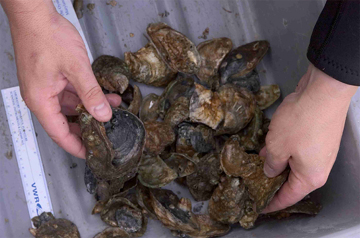Their shells look like rocks, and are just as hard. Their innards look like...well, innards. Yet oysters are a popular seafood, their meat grilled, added to soups and stews, or slurped down raw. In fact, oysters are too popular for their own good. Overfishing has decimated oyster beds around the country -- a loss not just for the oysters, but for entire marine habitats.
 A young oysterís favorite place to settle is atop other oyster shells. Credit: National Oceanic and Atmospheric Administration.
A young oysterís favorite place to settle is atop other oyster shells. Credit: National Oceanic and Atmospheric Administration.Oysters live in still, shallow waters along much of the world’s coastlines. Their young settle on the bottom by the time they’re a couple of weeks old. They cement themselves to a clean, hard surface, then stay put.
A young oyster’s favorite place to settle is atop other oyster shells. Multiple generations build up large beds or reefs. That provides shelter for small fish and shellfish, and feeding grounds for larger fish. And the oysters help keep the water clean by filtering out algae and small bits of organic debris.
But overfishing has wiped out many of these beds, and pollution has destroyed more. Oysters also soak up pollutants and the toxic algae in red tides, which makes them dangerous to eat. That combination has drastically cut the American oyster harvest. In 2010, it was just 28 million pounds -- about a third of the take in the mid-’90s, and an even smaller fraction of the levels of the early 20th century.
The loss of oyster reefs affects many other species -- from fish and shellfish to marine birds. It exposes coastlines to increased erosion from storms. And it deprives dinner tables of a slimy but popular treat.

